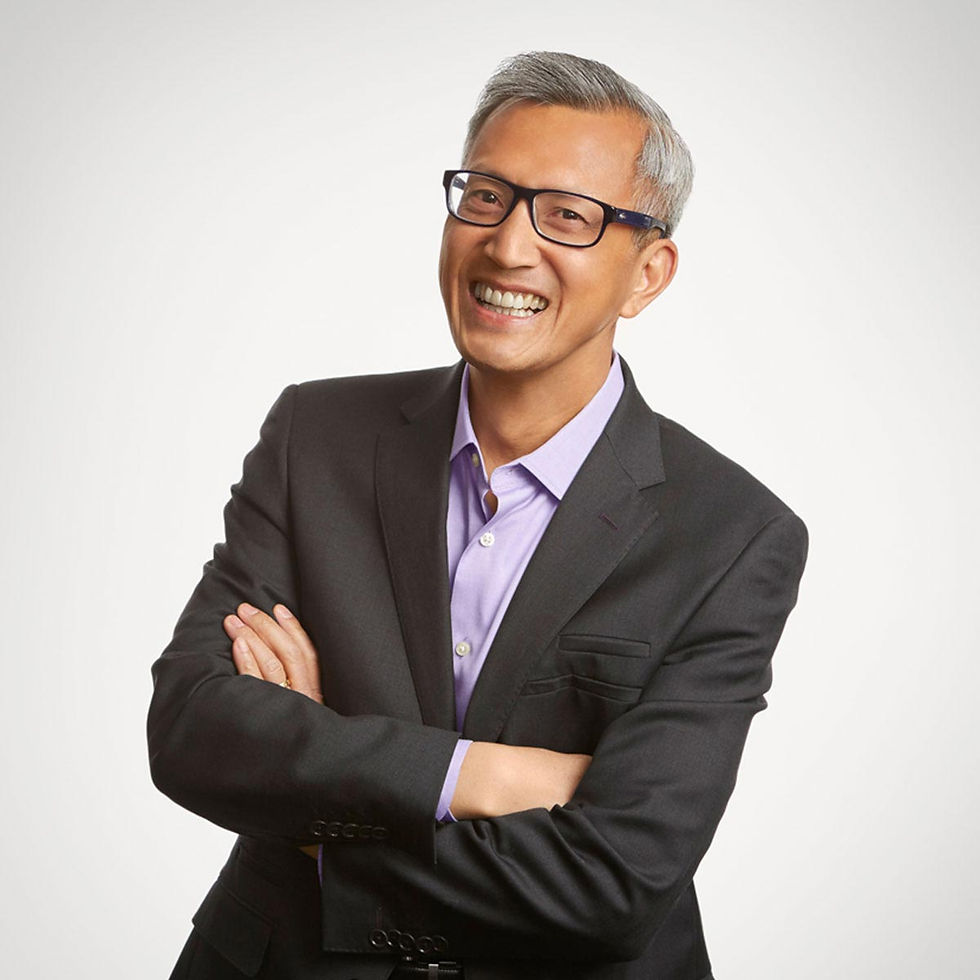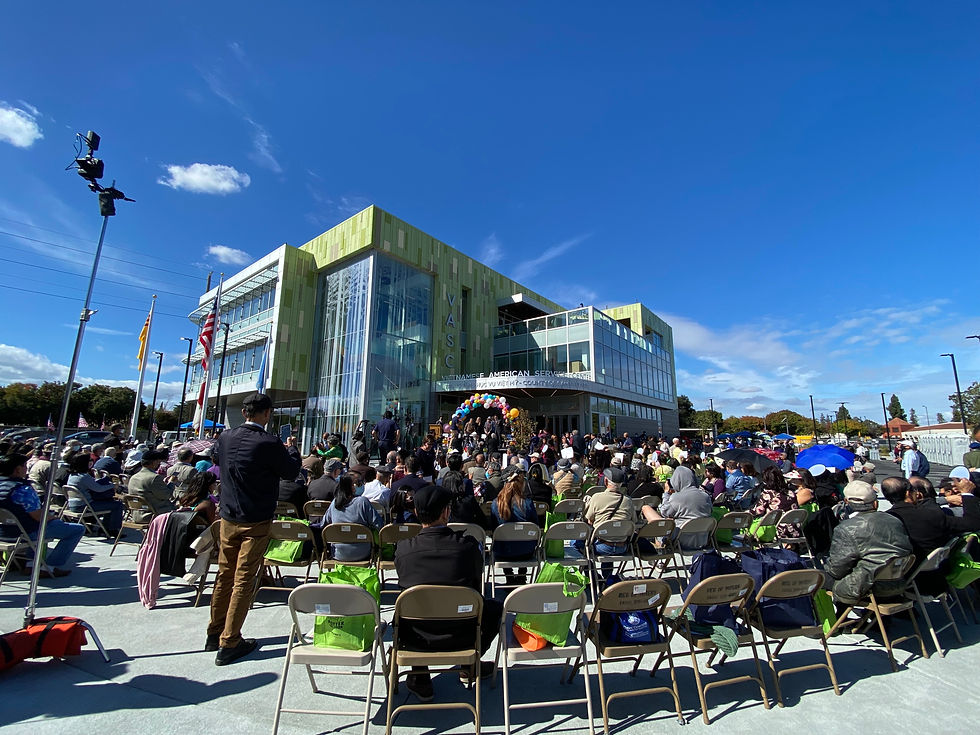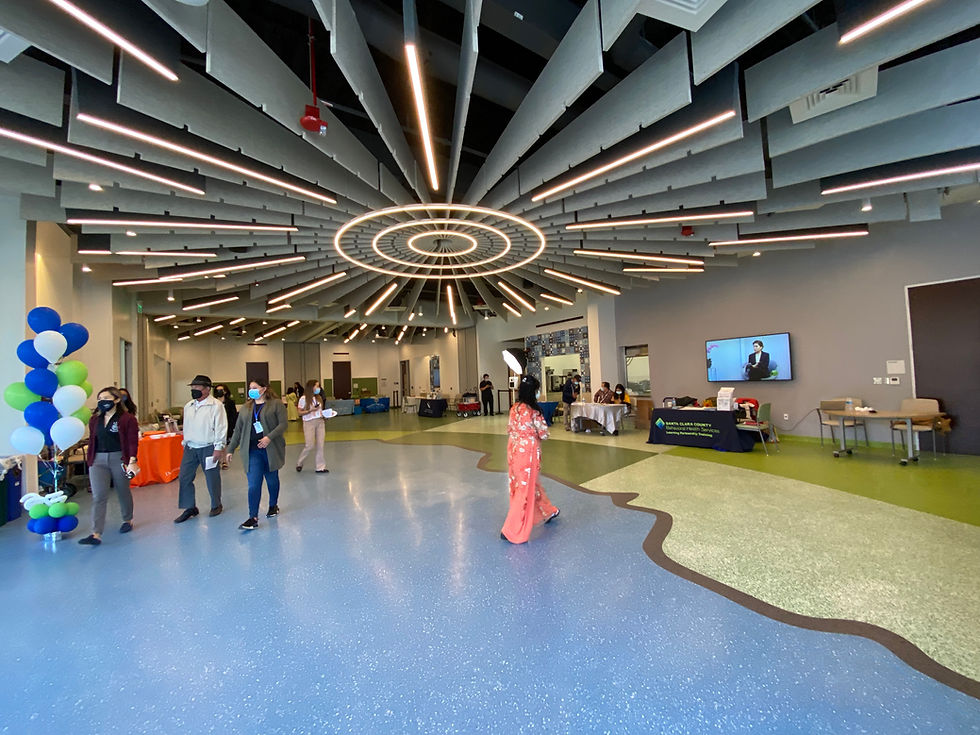Vietnamese American Service Center Now Open: Meet Architect Thang Do
- Harleen Kaur

- Nov 30, 2021
- 11 min read
On October 23, 2021, Santa Clara County opened the first facility of its kind in the United States, the Vietnamese American Service Center. This building, made for the Vietnamese community in San Jose, offers medical services, social services, and a community space. Chopsticks Alley attended the grand opening ceremony and the Vietnamese community coming together after a long time made a remarkable scene. One of the main things that caught my eye during the opening event was the building itself. Chopsticks Alley was able to get ahold of the main architect behind the beautiful building, Aedis Architect CEO Thang Do.
Please introduce yourself.

My full name in Vietnamese is Đỗ Nguyên Thắng. There is an interesting story about my middle name. It was supposed to be Nguyễn, which is the last name of an ancestor of the late 15th century whom my father chose to pay respect to. According to family history, this ancestor was a highly accomplished scholar and rose to become something akin to a prime minister in the court of the Lê kings. In a palace power struggle, he was killed and families on the sides of both of his parents and his wife were condemned to death, which was usual at the time when someone was charged with treason. To escape death, his descendants adopted their mother’s last name Đỗ, which remained the family’s last name ever since.
I am married with four children, ranging in age from 10 to 15. My wife is an immigrant from China and the two of us see eye to eye on almost every issue of importance. I designed our family house around the needs and imagination of our children, including secret lofts, a separate play house and a zip line. It is the house that I would have dreamed of when I was myself a child.
How was early life in Vietnam?
I was born on the outskirts of Sài Gòn (now Ho Chi Minh City; Sài Gòn back then was a much smaller city). My parents moved to the mountain resort town of Đà Lạt when I was one or two years old. I think of Đà Lạt as my hometown, even though I was not born there. The first eight years or so of my life were relatively peaceful, although I did live through and have vague memory of important events, like the coup d’état that brought down the Ngô Đình Diệm regime, and the Buddhist unrest that went on for several years in the mid 1960’s.
The Tet offensive of 1968 was my first taste of the Vietnam war, when battles were fought right near my house, with planes and helicopters dropping bombs and shooting rockets in front of our eyes. In late March of 1975, the government abandoned Đà Lạt as one after another South Vietnam cities fell to the advancing communist army.
My family managed to fly to Sài Gòn, from where we were evacuated out of the country a month later. We arrived in Guam on April 24, 1975 and eventually made it to the U.S. We first settled in Reno, Nevada and in early 1980 moved to San Jose, California, where the economy was booming due to the semiconductor industry. We found ourselves part of a large Vietnamese refugee population that had settled here for the same reason as ours.
I read on your website that you became a partner for Aedis Architecture in the early 1990’s, how did that come about and what was that experience like?
As a refugee and a relatively new immigrant, I supported myself through college. I had worked in various engineering and architectural firms before going to architecture school at Cal Poly, San Luis Obispo. The last place I worked at was a small firm named PJHM Architects that specialized in educational facilities. I worked there for 2 years, then left to attend school, but came back to work during the summer and other breaks. In 1984, I went to Florence, Italy for one year of study abroad before graduating from architecture school.
My plan upon graduation was to move to New York or some other large metro areas to work for a big name architect. A few weeks before graduation, my old boss from PJHM called and asked about my career plans. He then told me that he really wanted me to come back to his firm. He said that his partner and he were looking to retire, and they wanted me to take over the firm. For a 25-years-old new graduate, this was too tempting an offer to pass up. At the time, economic security was my main priority, as I had elderly parents that I wanted to help support.
So I came back to my old firm and my bosses kept their promise. They placed more and more management responsibility on me and after about 5 years, they announced that I would be the new leader of the firm, with several supporting associates. I rose to this position when I was barely 30, a young age in my profession. In hindsight, this was both good and bad. Clearly, being a partner/leader in a firm gave me tremendous opportunities and allowed me to earn an income many times more than I could have otherwise. On the flip side, I was also not truly ready for the role. I think that I was a strong business leader, and the firm grew from about a dozen employees when I took over to over 50 about 15 years later.
Were they any challenges you faced to receive the position of partner?
I never had business or marketing training, and I had not worked for other firms except for short stints at a low level position. It was all learning on the job, and at times it was lonely as I had no one to bounce off ideas. I had to make tough decisions at times, especially on personnel issues. In the first couple of decades, I was a top-down type of leader, which helped the company grow. As I became more mature, I learned better collaboration and delegation skills that broadened the leadership of the firm. This transition was key to both the work environment at the company and to my own mental health. I wasn’t conscious of the difficulties I faced as an immigrant for whom English was a second language, even though they clearly existed. Like many new immigrants, I was very focused and goal-oriented, which helped me overcome these shortcomings.
The first stage of my career was to establish myself as a firm leader. The second stage started in about 2008, when I was appointed to the San Jose Planning Commission, which started my journey of being active in community work, especially around urban planning generally and Downtown San Jose specifically. That involvement led to other opportunities, such as being selected for the San Jose Architectural Review Committee and being invited to the board of nonprofits such as SPUR, Silicon Valley Housing Trust, and the San Jose Museum of Art. The American Institute of Architects recognized these contributions by elevating me to the College of Fellows of the institute, which admits only about 3 percent of AIA architects.
What was the next step after receiving your position of Partner?
Aside from my community involvement, I became passionate about environmentalism, especially the role that architects play in affecting climate change. Our new office in Downtown San Jose was given a LEED Platinum certification in 2014, the highest environmental rating for buildings at the time. We designed the first several zero-net-energy school buildings in California, and began to use mass timber in construction. Mass timber is an innovative way of using wood that has been assembled into large structural mass. It’s great for the environment because timber sequesters carbon from being released into the atmosphere for the life of the structures. We were among the first California architects to embrace this new way of building, and we used it in schools and tall housing projects. I also collaborated with Valley Verde to start the first urban farm in San Jose. In 2019, the League of Conservation Voters named me environmentalist of the year.
The third stage of my career started a few years ago, when I became a developer to create more impacts on Downtown San Jose. In partnership with others, I am developing several high-density housing projects to be a part of the solution to the housing crisis. I try to be an active and visible housing advocate.
How did you first come to know of the Vietnamese American Service Center project?
I had been aware of the project during its formative phase and when the County issued a Request for Qualifications, my firm submitted. We got past the first round and made the shortlist which involved an in-person presentation and interview. We were selected for a number of reasons, many of which were related to experience and professional accomplishments, but a key differentiator was our cultural competency, which was high on the list of selection criteria.

What was the biggest challenge you faced when working on the design for the Service center?
Like other projects of this magnitude, fitting the required program into the budget and schedule is not always an easy task, but the overriding challenge was to generate a design that embodies Vietnamese culture, as the Vietnamese American community yearned for. We wanted the building to be a place where the users and visitors would immediately recognize uniquely Vietnamese aspects without resorting to cliches or creating an environment that may cause discomfort for non-Vietnamese Americans.
What are some architectural feats of the building that you are most proud of or would like to highlight?
The design of the building embraces principles of environmental sustainability, including being zero-net-energy ready. All spaces that are used regularly by staff and visitors have ample natural light and view, with the exception of the interior exam rooms. The building is one of the first non-residential all-electric buildings in the area, without any use of fossil fuel that generates carbon emission.
The layout of the building is welcoming and easy for users to orient themselves to find their way around, aided by graphics that use friendly colors and imagery. The main dining/multi-purpose hall on the ground floor as well as the shared community space on the third floor have large folding glass doors that open directly to the exterior, creating a seamless interior-exterior connection.

I attended the opening ceremony, and I felt that this was such an important event and milestone for the Vietnamese-American community. What does this project mean to you and what do you think it means for the community?
I am extremely grateful to have had the opportunity to design the building, with the help of my team and others. The design process helped me forge a stronger relationship with the Vietnamese American community as well as revive my own connection with Vietnamese culture and history. I got to know many community members, especially the elderly ones and appreciated the commitment they have to build a center such as this.
This is a huge milestone for not only the Vietnamese American community of Santa Clara County, but throughout the United States. The community takes great pride in the fact that the center has finally become a reality and moreover, in how it has turned out. The design language, architectural symbols and cultural references seem to resonate with Vietnamese Americans. I don’t think it’s an exaggeration to say that this is now the new symbolic home for the Vietnamese American community here. For a long time, like any immigrant and refugee communities, we struggled with the concept of home: where was our home? This center helps answer that question. The United States, and more specifically, Santa Clara County, is our home.
What was the inspiration behind some of the cultural aspects of the design?
I thought about what tends to remind me of the old country the most. What came to my mind was music, and specifically this iconic song by Vietnam’s most famous and prolific composer Phạm Duy, named Tình Ca (the song of love). I grew up with that song, which had 3 parts: love of the maternal language; love of the land; and love of the people. The song is full of vivid imagery and expresses its author’s love of his country in the deepest and most heartfelt way.
The lobby window facing the street is framed with a large letter V painted in a bright yellow. V of course signifies the Viet people that make up today’s Vietnam. On the ground, the easily recognized S-shape Vietnamese coast line is engraved into the pavement, with one side painted blue to represent the sea, and on the other side various shades of colors to symbolize the rice fields.
A plaza welcomes visitors into the main entrance of the center. The plaza is animated by a diaspora diagram, which consists of a series of circles of different sizes that represent the main destinations in the world that opened their arms to welcome Vietnamese refugees after the collapse of South Vietnam in 1975. A row of boulders, capped by glass plaques that memorialize the key events of the Vietnamese diaspora, frames the edges of the plaza.
The building is clad in a green and light brown metal panel to resemble a bamboo grove that protects the traditional Vietnamese village. The bamboo pattern is also etched into the large glass windows of the main stairs. In the interiors, one can see vivid images of the Vietnamese countryside and flora. The main hall has a ceiling of a circular pattern that represents the iconic Vietnamese conical hat.

How does it feel that the Vietnamese American Service Center is a building that is the first of its kind in America?
It’s less about me as an architect/designer than it is about the recognition and acceptance of the Vietnamese American community as an ethnic group who has made significant contributions to this country. Vietnamese were forced to flee their country and for a long time, their feelings were torn between nostalgia for the old country and the realization that it was not possible for them to ever return to their homeland due to fear of persecution. While a large number of Vietnamese were able to assimilate successfully into the American social fabric, many continued to live on the margin. The fact that a government entity - the County of Santa Clara - recognized the many needs of this community to the point of spending significant resources to build a magnificent center, the first of its kind in the world, means that this community has found their home.

How do you feel your Vietnamese-American Identity has shaped you?
My life and career share similarities with those of many first-generation immigrants. In essence, we all have lived two lives, one before we came to this country and the other as an immigrant. In the process of establishing our own place in a new society, we were not aware of or willfully disregarded the difficulties we encountered at the beginning. Once our families were relatively secure, we realized that we could be more impactful on larger issues, as well as help those less fortunate and those experiencing what we had once experienced. This country has been built by generations of immigrants; it has come a long way but it remains a work in progress, and as new Americans, we have a responsibility to build upon the work of preceding immigrants. In almost everything I do nowadays, I think of future generations, those of my children and beyond. I want my generation to leave a better country and world for all of them, which means we must be active and engaged toward a brighter future.
I became politically active in the last 5 years, when I felt that the country was in danger of falling into despotism, and my Vietnamese American community in particular was victimized by fake news and sinister divisive efforts. I joined an organization that was formed by the same motivations called PIVOT - The Progressive Vietnamese American Organization, and became a board member. We worked hard to turn out Asian American votes in national elections. I contributed personally with a significant amount of English-Vietnamese translation as well as writing mostly in the Vietnamese language.

The Vietnamese American Service Center is now open and running. If you are in the area, I would highly recommend dropping by to look at the design and enjoy the center made for the Vietnamese American community.
If you like stories like this, subscribe to Chopsticks Alley.

Harleen Kaur
Chopsticks Alley Editorial Intern
Harleen is a freshman at Foothill College pursuing her B.A. in philosophy. She ran her high school’s newspaper PHHS The Legend as a managing editor, and was later inducted into the Quill and Scroll Honor Society as a lifetime member. Growing up in San Jose, Harleen hopes to write about and amplify the voices of the Vietnamese and Pinoy community that she is surrounded by. She hopes to become a lawyer who will give back to her community.




South Delhi Escort Service will provide 100% verifiable and reliable escorts. Everything has been vetted for you so you can trust the woman you are spending time with and feel safe.
SLOT777
SLOT QRIS
SLOT THAILAND
TOTO SLOT
RAJA SLOT
SLOT GACOR
RAJA SLOT
RAJA SLOT
SLOT GACOR
SLOT GACOR
SLOT GACOR
SLOT DANA
SLOT GACOR
RAJA SLOT
SLOT GACOR
SLOT QRIS
SLOT88
SLOT DEMO
SLOT88
SLOT88